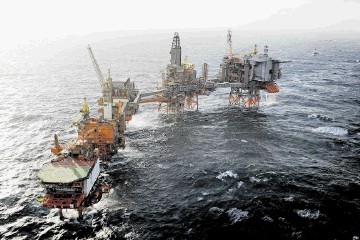
A Norwegian oil field given an extra 40 years of life after a multibillion-pound investment has been brought back on stream.
Operator BP said the Valhall complex was expected to build up to about 65,000 barrels of oil equivalent per day (boepd) in the second half of this year.
Output before the redevelopment project was about 40,000 boepd.
Work on the field in the North Sea included a new production, utilities and accommodation platform and a system providing power from the shore.
Output had been shut since July last year to move over to the new platform.
“The Valhall redevelopment project is another significant milestone for BP and is an important investment in our North Sea portfolio,” said BP chief executive Bob Dudley.
He added: “It is one of BP’s most complex field-expansion developments and gives Valhall a further 40-year design life, with the capacity to handle 120,000 barrels of oil and 143million cubic feet of gas per day.”
BP has previously said the Valhall redevelopment, along with its Skarv project – a floating production platform in the Norwegian sector that came online earlier this month – would help increase the firm’s output in Norway from 30,000 boepd to 60,000.
This would make the firm’s Norwegian production count for a third of its overall North Sea output.
BP Norway is the operator of Valhall, with a 35.9% interest. Hess Norge owns the remaining 64.1%.
The redevelopment means Valhall is now wholly powered from shore thanks to a 182-mile cable from Lista, the first field offshore Norway and within BP to use such a system. BP said this would make direct emissions to air from the Valhall field close to zero.
Including the new platform, the Valhall field complex now has six separate manned platforms – quarters, drilling, production, wellheads, water injection and the new combined process and hotel platform.
First production from the Valhall field, discovered in 1975, came in 1982.
Recommended for you
